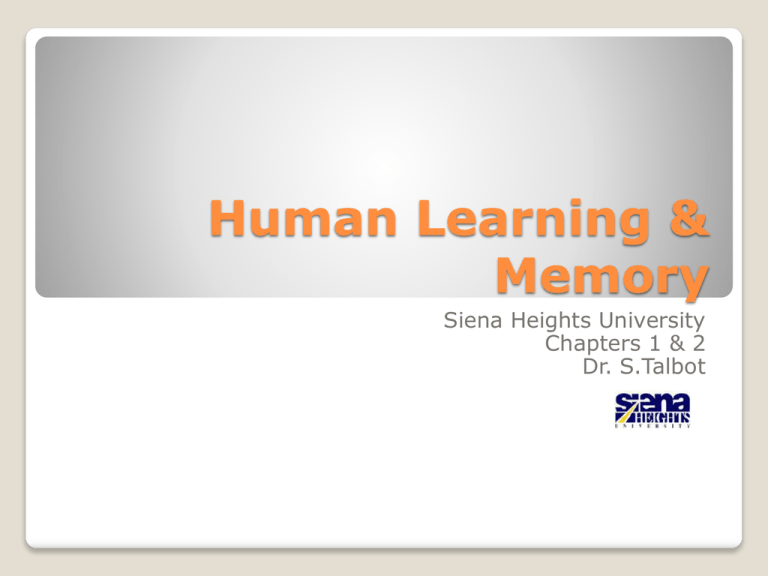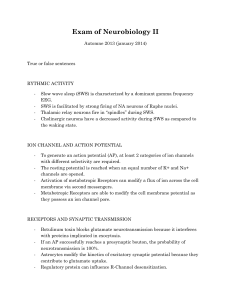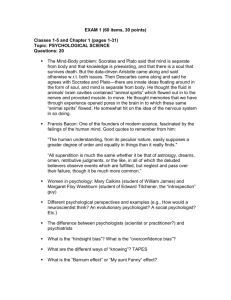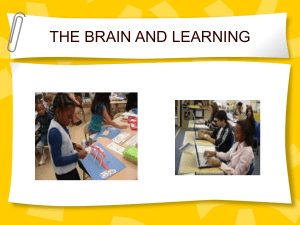Human Learning & Memory
advertisement

Human Learning & Memory Siena Heights University Chapters 1 & 2 Dr. S.Talbot Why is learning important? Definition of learning:a ______-term change in mental ________ or representations as a result of ________. The role of behavior in learning. ◦ ◦ ◦ ◦ ◦ New behaviors Frequency of behaviors Speed of behaviors Complexity or intensity Changing behaviors Chapter 1 – Perspectives on Learning Principles (the what) : describe factors that result in effects. ◦ Fairly stable for similar circumstances. Theories (the why): explain the relationship between factors and effects. ◦ Based on data. ◦ Not facts. ◦ Change based upon information and perspective. Chapter 1 – Perspectives on Learning Evolution of Theories ◦ ◦ ◦ ◦ ◦ ◦ ◦ ◦ Structuralism (Wundt) 1800s Functionalism (Dewey) Behaviorism (Watson) early 1900s Social Learning Theories (Miller & Dollard) Gestalt (1920s) Cognitive Psychology (Piaget) Mid to late 20th century Social Cognitive Sociocultural Theory Chapter 1 – Perspectives on Learning Advantages of theories ◦ ◦ ◦ ◦ ◦ Summarize or describe. Starting points for conducting new research. Explain. Provide the ability to predict outcomes. Allow for practical application in order to necessitate change. Sound familiar? Dangers or drawbacks to theories ◦ No single theory works for everything. ◦ Past theories affect or bias new theories. They can impede new thinking. Biggest danger. ◦ They are not ______. Give them their rightful credit, but nothing more. Chapter 1 – Perspectives on Learning Chapter 2 Chapter 2 –Learning & the brain Central Nervous System (CNS): Brain and spinal cord Peripheral Nervous System: All parts of the nervous system outside of the brain and spinal cord ◦ Somatic System: Links spinal cord with body and sense organs; controls voluntary behavior ◦ Autonomic System: Serves internal organs and glands; controls _________ functions such as heart rate and blood pressure Chapter 2 –Learning & the brain Sympathetic: Arouses body; emergency system Parasympathetic: Quiets body; most active after an emotional event Two Divisions of the Autonomic System Neuron: Individual nerve cell ◦ Dendrites: Receive messages from other neurons ◦ Soma: Cell body; body of the neuron ◦ Axon: Fiber that carries information away from the cell body ◦ Axon Terminals: Branches that link the dendrites and somas of other neurons Neuron and Its Parts Nerves: Large bundles of axons and dendrites (Not neurons) Myelin: Fatty layer of tissue that coats axons ◦ Multiple Sclerosis (MS) occurs when myelin layer is destroyed; numbness, weakness, and paralysis occur Neurogenesis: Production of new brain cells Nerves and Neurons Sensory Neurons- bring incoming messages from sensory sites. Interneurons – consider & interpret the information which has been received. Motor Neurons – send messages concerning the appropriate response. Glial Cells – White Matter (the stuff in between) Chapter 2 –Learning& the brain Synapses Messages from one neuron to another pass over a microscopic gap called a synapse ◦ Synapse: Microscopic gap between two neurons over which messages pass Neurotransmitters Chemicals that alter activity in neurons; Brain chemicals that carry messages. ◦ Acetylcholine: Activates muscles ◦ Dopamine: Muscle control ◦ Serotonin: Mood and appetite control Neural Peptides: Regulate activity of other neurons ◦ Endorphins: Released by pituitary gland; also help to relieve pain ◦ Do not _____ messages. Chapter 2 –Learning& the brain Methods for brain research ◦ ◦ ◦ ◦ ◦ Animals Postmortem Studies Case studies of people with brain injuries Electrical recording (EEG) Neuroimaging PET CT/CAT SPECT MRI fMRI Chapter 2 –Learning& the brain This simplified drawing shows the main structures of the human brain and describes some of their most important features. (You can use the color code in the foreground to identify which areas are part of the forebrain, midbrain, and hindbrain.) Hindbrain (Brainstem) ◦ Medulla: Connects brain with the spinal cord and controls vital life functions such as heart rate and breathing ◦ Pons (Bridge): Acts as a bridge between medulla and other structures Influences sleep and arousal ◦ Cerebellum: Located at base of brain Regulates posture, muscle tone, and muscular coordination Subcortex Lies inside medulla and brainstem ◦ Associated with alertness, attention and some reflexes (breathing, coughing, sneezing, vomiting) Reticular Activating System (RAS): Part of RF that keeps the cortex active and alert Its alarm clock Subcortex: Reticular Formation (RF) Parts of the limbic system. Although only one side is shown here, the hippocampus and the amygdala extend out into the temporal lobes at each side of the brain. The limbic system is a sort of “primitive core” of the brain strongly associated with Definition: Outer layer of the cerebrum Cerebrum: Two large hemispheres that cover upper part of the brain Corticalization: Increase in size and wrinkling of the cortex Cerebral Hemispheres: Right and left halves of the cortex Corpus Callosum: Bundle of fibers connecting cerebral hemispheres Cerebral Cortex Brain Development ◦ Prenatal (5th – 20th week, 50k – 100k per second). ◦ Infancy and childhood Mylenation Synaptic Pruning Synaptogenesis Differentiation ◦ Middle Childhood, Adolescence, and Adulthood Chapter 2 –Learning& the brain Factors Affecting Brain Development ◦ Heredity ◦ Environmental factors ◦ Experiences Critical Periods ◦ Plasticity Chapter 2 –Learning& the brain Educational Implications ◦ Loss of synapse is inevitable and desirable. ◦ Many environments nurture normal brain development (enriching v. depriving). ◦ The early years are important for learning. ◦ No such thing as teaching to the right brain or left brain. ◦ Critical periods are important but are not definitive. ◦ Brain research can help us, but can’t/won’t tell us everything. Chapter 2 –Learning& the brain Questions & Discussion Next Class ◦ ◦ ◦ ◦ Applied Behavior Analysis Instructional Objectives Computer Assisted – Instruction Mastery Learning & PSI Chapter 2 –Learning& the brain











